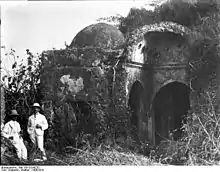Islam in Tanzania
Islam in Tanzania is the second largest religion in the country after Christianity. There are no reliable statistics, figures claimed vary between 35%[2] and "almost half"[3] of the people of Tanzania. On the mainland, Muslim communities are concentrated in coastal areas, with some large Muslim majorities also in inland urban areas especially and along the former caravan routes. More than 99% of the population of the Zanzibar archipelago is Muslim. The majority of Muslims in Tanzania are Sunni of Shafi school of jurisprudence, with unusually significant Shia and Ahmadi minorities in sub-Saharan Africa. According to Pew research center, two-thirds of the Muslim population of Tanzania is Sunni, while the rest is either Shia (20%) or Ahmadi (15%)[4] besides a smaller subset of Ibadism and nondenominational Muslim practitioners.[5]
 | |
| Total population | |
|---|---|
| approx. 16.73 million (35%)[1] | |
| Website | |
| www |
History

The earliest concrete evidence of a Muslim presence in the African Great Lakes is the foundation of a mosque in Shanga on Pate Island, where gold, silver and copper coins dated from 830 were found during an excavation in the 1980s. Islam arrived to Tanzania with the Arab slave traders. The route from Ujiji at the shore of Lake Tanganyika to Bagamoyo, just opposite of Zanzibar on main land Tanzania was one of the main routes of Muslim slave routes according to UNESCO data.[6]
The history of Islam in the country can be traced to the establishment of the Kilwa Sultanate in the 10th century by Ali ibn al-Hassan Shirazi,[7] a Persian prince of Shiraz.[8]
See also
References
- "The World Fact Book: Tanzania". Retrieved 26 January 2014.
- Pew-Templeton Global Religious Futures Project, Tanzania, Pew Research Center, 2016, retrieved 1 March 2019
- "BBC News | Africa | Tanzanian police break up Muslim protest". news.bbc.co.uk. 30 July 1999. Retrieved 2019-05-02.
- "The World's Muslims: Unity and Diversity" (PDF). Pew Forum on Religious & Public life. August 9, 2012. Retrieved August 14, 2012.
- Wortmann, Kimberly T. Omani Religious Networks in Contemporary Tanzania and Beyond. Diss. 2018.
- Centre, UNESCO World Heritage. "The Central Slave and Ivory Trade Route - UNESCO World Heritage Centre". whc.unesco.org. Retrieved 22 April 2018.
- شاكر مصطفى, موسوعة دوال العالم الأسلامي ورجالها الجزء الثالث, (دار العلم للملايين: 1993), p.1360
- James Hastings, Encyclopedia of Religion and Ethics Part 24, (Kessinger Publishing: 2003), p.847
